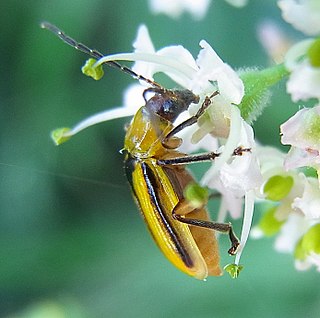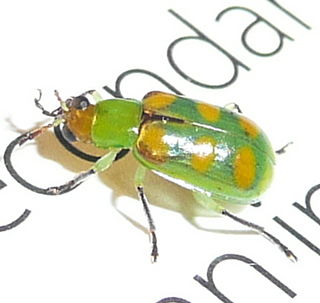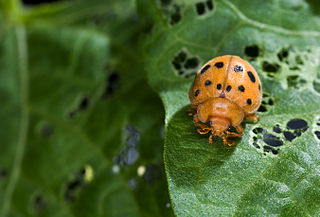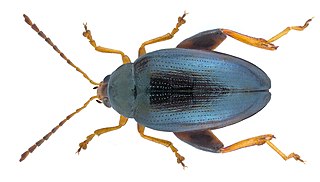
Flea, the common name for the order Siphonaptera, includes 2,500 species of small flightless insects that live as external parasites of mammals and birds. Fleas live by ingesting the blood of their hosts. Adult fleas grow to about 3 millimetres long, are usually brown, and have bodies that are "flattened" sideways or narrow, enabling them to move through their hosts' fur or feathers. They lack wings; their hind legs are extremely well adapted for jumping. Their claws keep them from being dislodged, and their mouthparts are adapted for piercing skin and sucking blood. They can leap 50 times their body length, a feat second only to jumps made by another group of insects, the superfamily of froghoppers. Flea larvae are worm-like, with no limbs; they have chewing mouthparts and feed on organic debris left on their hosts' skin.

Helicoverpa zea, commonly known as the corn earworm, is a species in the family Noctuidae. The larva of the moth Helicoverpa zea is a major agricultural pest. Since it is polyphagous during the larval stage, the species has been given many different common names, including the cotton bollworm and the tomato fruitworm. It also consumes a wide variety of other crops.

The insects of the beetle family Chrysomelidae are commonly known as leaf beetles, and include over 37,000 species in more than 2,500 genera, making up one of the largest and most commonly encountered of all beetle families. Numerous subfamilies are recognized, but the precise taxonomy and systematics are likely to change with ongoing research.

The Western corn rootworm, Diabrotica virgifera virgifera, is one of the most devastating corn rootworm species in North America, especially in the midwestern corn-growing areas such as Iowa. A related species, the Northern corn rootworm, D. barberi, co-inhabits in much of the range and is fairly similar in biology.

Stewart's wilt is a serious bacterial disease of corn caused by the bacterium Pantoea stewartii. This bacterium affects plants, particularly types of maize such as sweet, flint, dent, flour, and popcorn. The disease is also known as bacterial wilt or bacterial leaf blight and has shown to be quite problematic in sweet corn. The disease is endemic in the mid-Atlantic and Ohio River Valley regions and in the southern portion of the Corn Belt.

The scarlet lily beetle, red lily beetle, or lily leaf beetle, is a leaf beetle that eats the leaves, stem, buds, and flowers, of lilies, fritillaries and other members of the family Liliaceae. It lays its eggs most often on Lilium and Fritillaria species. In the absence of Lilium and Fritillaria species, there are fewer eggs laid and the survival rate of eggs and larvae is reduced. It is now a pest in most temperate climates where lilies are cultivated.

The flea beetle is a small, jumping beetle of the leaf beetle family (Chrysomelidae), that makes up the tribe Alticini which is part of the subfamily Galerucinae. Historically the flea beetles were classified as their own subfamily.

Phyllophaga is a very large genus of New World scarab beetles in the subfamily Melolonthinae. Common names for this genus and many other related genera in the subfamily Melolonthinae are May beetles, June bugs, and July beetles. They range in size from 12 to 35 mm and are blackish or reddish-brown in colour, without prominent markings, and often rather hairy ventrally. These beetles are nocturnal, coming to lights in great numbers.

Diabrotica undecimpunctata, the spotted cucumber beetle or southern corn rootworm, is a species of cucumber beetle that is native to North America. The species can be a major agricultural pest insect in North America. Spotted cucumber beetles cause damage to crops in the larval and adult stages of their life cycle. Larvae feed on the roots of the emerging plants, which causes the most damage since the young plants are more vulnerable. In the adult stage the beetles cause damage by eating the flowers, leaves, stems, and fruits of the plant The beetles can also spread diseases such as bacterial wilt and mosaic virus.

The spined soldier bug is a species of stink bug common in North America. They are predators of gypsy moth caterpillars and the larvae of beetles such as the Colorado potato beetle and the Mexican bean beetle. Since the Mexican bean beetle is widely regarded as a notorious agricultural pest in North America, soldier bugs are generally considered to be beneficial garden insects.

Agrotis ipsilon, the dark sword-grass, black cutworm, greasy cutworm, floodplain cutworm or ipsilon dart, is a small noctuid moth found worldwide. The moth gets its scientific name from black markings on its forewings shaped like the letter "Y" or the Greek letter upsilon. The larvae are known as "cutworms" because they cut plants and other crops. The larvae are serious agricultural pests and feed on nearly all varieties of vegetables and many important grains.

Coccinellidae is a widespread family of small beetles ranging in size from 0.8 to 18 mm. The family is commonly known as ladybugs in North America and ladybirds in Great Britain and other parts of the English-speaking world. Entomologists prefer the names ladybird beetles or lady beetles as these insects are not classified as true bugs.

Xanthogaleruca luteola, commonly known as the elm-leaf beetle, is a beetle species in the family Chrysomelidae that is native to Europe but invasive in other parts of the world.

The striped flea beetle is a small flea beetle, shiny black with a greenish tinge, 1.5 to 2.5 mm long, having a wavy amber line running the length of each elytron. It is a pest of cabbage and other brassicas. The hind legs are thickened, enabling the beetle to jump like a flea when disturbed.

Diabrotica speciosa, also known as the cucurbit beetle and in Spanish as vaquita de San Antonio is an insect pest native to South America. Its larvae feed on the roots of crops. The cucurbit beetle is also known to transmit several viruses such as comoviruses and different mosaic viruses. Diabrotica speciosa is native to South America and is now distributed in Central America and other global areas.

Coleomegilla maculata, commonly known as the spotted lady beetle, pink spotted lady beetle or twelve-spotted lady beetle, is a large coccinellid beetle native to North America. The adults and larvae feed primarily on aphids and the species has been used as a biological control agent. Based on name connotation and to avoid confusion with other species also called "spotted ladybeetle", spotted pink ladybeetle is probably the most appropriate common name for this species.

Galerucella calmariensis is a species of leaf beetle in the family Chrysomelidae. It is commonly known as the black-margined loosestrife beetle and is native to Europe and Asia where both adults and larvae feed on purple loosestrife. It has been introduced in North America as a biological control agent for purple loosestrife.

The Epilachninae are a subfamily of the family of lady beetles, the Coccinellidae, in the order Coleoptera. Superficially, they look much like other ladybirds in the larger subfamily Coccinellinae, but they differ importantly in their biology, in that the members of the subfamily are largely or completely leaf-feeding herbivores rather than being predators. Accordingly, several members of the subfamily are crop pests, and sometimes cause locally serious crop losses.

Psylliodes chrysocephala or Psylliodes chrysocephalus, commonly known as the cabbage-stem flea beetle, is a species of leaf beetle situated in the subfamily Galerucinae and the tribe Alticini.



















